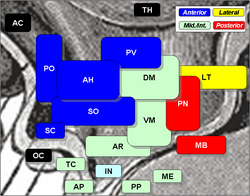Suprachiasmatic nucleus
| Suprachiasmatic nucleus | |
|---|---|

Suprachiasmatic nucleus is SC, at center left, labelled in blue.
The optic chiasm is OC, just below, labelled in black. |
|

The left optic nerve and the optic tracts. (Suprachiasmatic nucleus not labeled, but diagram illustrates region.)
|
|
| Details | |
| Identifiers | |
| Latin | nucleus suprachiasmaticus |
| MeSH | A08.186.211.730.385.357.342.625 |
| NeuroNames | hier-367 |
| NeuroLex ID | Suprachiasmatic nucleus |
| TA | A14.1.08.911 |
| FMA | 67883 |
|
Anatomical terms of neuroanatomy
[]
|
|
The suprachiasmatic nucleus or nuclei (SCN) is a tiny region of the brain in the hypothalamus, situated directly above the optic chiasm. It is responsible for controlling circadian rhythms. The neuronal and hormonal activities it generates regulate many different body functions in a 24-hour cycle, using around 20,000 neurons.
The SCN interacts with many other regions of the brain. It contains several cell types and several different peptides (including vasopressin and vasoactive intestinal peptide) and neurotransmitters.
The SCN is situated in the anterior part of the hypothalamus immediately dorsal, or superior (hence supra) to the optic chiasm (CHO) to (on either side of) the third ventricle.
Different organisms such as bacteria, plants, fungi, and animals, show genetically-based near-24-hour rhythms. Although all of these clocks appear to be based on a similar type of genetic feedback loop, the specific genes involved are thought to have evolved independently in each kingdom. Many aspects of mammalian behavior and physiology show circadian rhythmicity, including sleep, physical activity, alertness, hormone levels, body temperature, immune function, and digestive activity. The SCN coordinates these rhythms across the entire body, and rhythmicity is lost if the SCN is destroyed. For example, total time of sleep is maintained in rats with SCN damage, but the length and timing of sleep episodes becomes erratic. The SCN maintains control across the body by synchronizing "slave oscillators," which exhibit their own near-24-hour rhythms and control circadian phenomena in local tissue.
The SCN receives input from specialized photosensitive ganglion cells in the retina via the retinohypothalamic tract. Neurons in the ventrolateral SCN (vlSCN) have the ability for light-induced gene expression. Melanopsin-containing ganglion cells in the retina have a direct connection to the ventrolateral SCN via the retinohypothalamic tract. When the retina receives light, the vlSCN relays this information throughout the SCN allowing entrainment, synchronization, of the person's or animal's daily rhythms to the 24-hour cycle in nature. The importance of entraining organisms, including humans, to exogenous cues such as the light/dark cycle, is reflected by several circadian rhythm sleep disorders, where this process does not function normally.
...
Wikipedia
